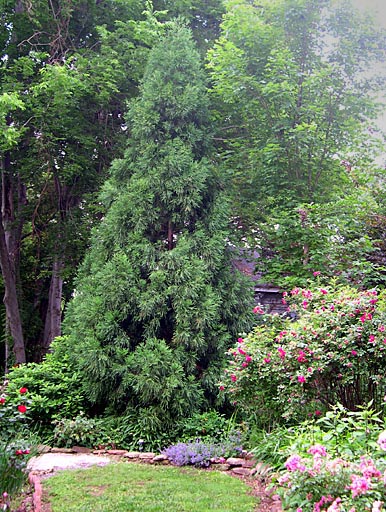Autumn Vibes
Eupatorium rugosum 'Chocolate' (Snakeroot) with Hydrangea 'Snow Queen' I love autumn - the crisp, cooler temperatures, the rain, and most of all, the fall colors. The year looks to be a nice one. I got back from a trip to Alabama last week and found that the colors were in full swing (unlike Alabama, where the temperatures were lovely with the exception of some mugginess but alas, no color at all). Japanese Maples are the first thing I think of when autumn comes to mind. This one is 'Bihou' and one of the first to change color. Acer palmatum 'Bihou' Other trees are beginning to change as well, including the Redbud 'Flame Thrower'. 'Flame Thrower' Redbud ( Cercis canadensis ) The star of the show now, however, is the Stewartia. It is just amazing and I remember it was beautiful last year as well. It's chief rivals, the Ginkgo and Black Tupelo, are only showing hints at the moment. Stewartia pseudocamellia The shady path - The most d...




Being able to see thru there has just made your garden much larger in appearance.
ReplyDeleteDon't you just hate it when the walls come tumbling down. It will take some getting used to. We lost another tree this spring. I have a wide open place at the end of the patio and this tree also acted as an umbrella to the patio. Now HOT sun. Booooo
ReplyDeleteThat's sad Phil.
ReplyDeleteThat's too bad, it's always sad to lose a tree. Perhaps try planting some Holly shrubs to re-create the "room" effect.
ReplyDeleteI can well imagine the disappointment that you are experiencing... having experienced these types of changes myself, I can relate. The loss of a 35 year old Leonard Messel magnolia a few years ago was very difficult to deal with for example... mainly because of how it fit into the landscape. I will say that I'm reasonably certain that with time and a healthy creative spirit, these changes can be embraced and often times I've grown to like the new 'possibilities'. Your tree was nothing short of majestic though... such a loss... Larry
ReplyDeleteOh your beautiful tree gone ... sorry for your loss.
ReplyDeleteHow sad - yet how fortunate the new view is lovely too. (And with potential!)
ReplyDeleteLucy
You'll love the change once the rose you've planted at the base of the tree gets going. It'll be beautiful.
ReplyDeleteI'm sorry Phillip. It's been a year of change in my garden too. I feel your pain especially since yours was such a stately tree. I guess though what we love so much about gardening *is* the sense of change. Here's to Peggy clambering up the side quickly.~~Dee
ReplyDeleteI was thinking of the state of your tree and the assessments of it the other day when I went outside and noticed the one I have is doing the same thing! I am hoping it is the wet weather causing the browning, but I have a feeling I am right behind you in taking it down. Such a big loss to the garden, but as Lucy said, there is now a lot of new potential!
ReplyDeleteI remember your previous post, and I am sorry it had to end like that. However, I am sure that eventually it will all work out - roses need more sun, right? Once your climber fills in the space, you will have your room effect back too!
ReplyDeleteoikes... that sucks. It was a beautiful tree.
ReplyDeleteI am so sorry. We lost a focal tree in our garden last year due to thrips and it is hard to get used to the change.
ReplyDeleteThis past winter was a hard one on my garden. I lost two weeping cherry trees and a paperbark maple that I've had several years. Sorry for your loss. Mary
ReplyDeleteWow...that is quite a change! I'm sure it's a bit difficult to re-think the space now, but I'm sure you'll make the best of it!
ReplyDeleteSorry you lost the Japanese Cedar. It was a magnificent tree and a real complement to your landscape. I like your plan and look forward to seeing the "changes" it makes to your garden.
ReplyDeleteSo sorry~That is a big loss and it was beautiful. I know that whatever you decide it will be gorgeous. gail
ReplyDeleteIt will take some getting used to but 'change' is the essence of life...and no where better to demonstrate that than in the garden. I agree that once your rose takes off it will be beautiful in that spot. But the photo of the tree in all it's glory is a lovely momento to hold on to. I just read your former post from Feb. where you showed the tree with the brown and got the fungal diagnosis. I am now pretty sure that's what we've been dealing with on several of our Leyland Cypress trees. In some cases, we've had to remove the trees, in other areas, we've cut off the affected limbs. I had no idea it could be a fungus...I thought it was due to lack of light but after reading about it I'm convinced that's what we've got. Am going to look into that fungicide recommended by your commenter, Connor.
ReplyDeleteSaw the link to this when I looked at your chrysanthemum post. I hope you've grown accustomed to it now. That is sad. I planted a dwarf crypto, 'Nana', and it is very sad looking too. Lots and lots of brown needles. I'll probably take it out. I lost several plants this year, probably due to drought, but the hardest was losing an oak tree, so I feel your pain.
ReplyDelete